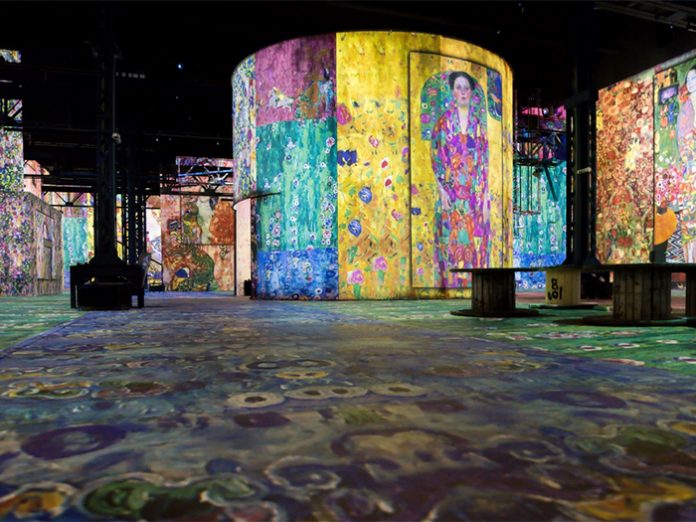Recently opened Atelier des Lumières by Culturespaces is the first Digital Art Centre in Paris. Its debut exhibition is an immersive digital experience around Gustav Klimt’s work and relies upon an audio-visual set-up, with more than 130 Barco video-projectors, as well as 35 Modulo Pi media servers.
Animated images of Klimt’s work are projected on the floor, on the walls as well as on the ceiling and other typical elements of the venue, such as the foundry’s former chimney. Images flow in rhythm to the music, and appear perfectly moulded to the Atelier’s architecture.
Faced with the technical challenge of equipping such a venue to achieve a 300 million pixels projection, Culturespaces and Cadmos, the integrator for the project, opted for Modulo Pi’s systems from the project study phase.
“The exhibition is tailor made to the venue”, explained Augustin de Cointet de Fillain, Multimedia Project Director at Culturespeaces. “In this context, you need a really flexible operating system.”
Augustin provides more detail about the crucial role played by Modulo Pi’s media servers prior to setting up: “We load a 3D plan of the venue, fill in the type of video-projector we’ll be using and what we want for each wall in terms of image pixel size and luminosity. Then, the Modulo Kinetic tells us where the VPs should be positioned, what the image distortion will be, the luminosity rendering on each area. Once this simulation phase is done on Modulo Kinetic, we move on to the venue.”
When at the venue, the installation and fine-tuning stages – central to the immersive effect – are done so as to give the impression of projecting one single image over the whole surface. Among other things, Modulo Kinetic helped handle the overlaps and soft edges, and made warping easy with the Xmap mode. Installation and fine-tuning had to be done within a limited time frame as Roman explained: “The audio-visual work comes at the very end. That was a real challenge to have everything set up and adjusted while the renovation work of the venue was still going on.”
Once the set-up was over, Modulo Kinetic was then used as a show controller to handle and sequence all media that are part of the show: videos, music, images. “That is the true force of Modulo Kinetic. It’s a comprehensive system in which anything can be centralised and controlled: videos, lights, sound, and interactive lasers”, commented Augustin.
Modulo Kinetic comes with an app that handles the shows through pre-programmed loops. Roman explained: “In our museum and contemporary art projects, Modulo Pi’s media servers allow us to work with Apple ProRes or uncompressed contents for better image quality. We also enjoy the capability of integrating custom show control and management options so that our clients can benefit from fully controllable and autonomous systems.”
Culturespaces is currently working on the launch of new immersive art exhibitions in the United States and Korea. These new large-scale projects will also rely upon Modulo Kinetic for the simulation, set-up, and show control and maintenance operations.
Augustin concluded: “It helps us anticipate future creations which is very important. This way, we don’t have to close our venues for too long. That gives us a very enjoyable anticipation base.”





